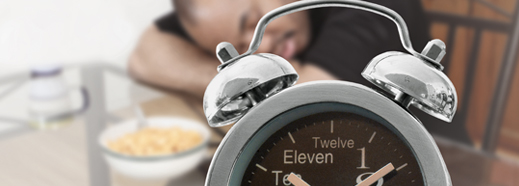Non-24: Impact on Health and Daily Living
While most people live according to a 24-hour social day and maintain a regular sleep-wake schedule, the Non-24 patient displays periodically recurring problems with sleep initiation, sleep maintenance, and waking, as the circadian cycle of wakefulness and sleep moves in and out of synchrony with the fixed social sleep episode.1
When circadian rhythms are out of phase with conventional sleep-wake patterns, as they may be in patients who are blind with Non-24, these patients may suffer a decrease in well-being such as2:
- Impairment in sleep duration, timing, and quality3
- Alterations in mood3
- A reduction in daytime functioning and participation in social activities3
- Potential impact on metabolic and cardiovascular homeostasis2
Read on to know what symptoms to look for in your patients who are totally blind.

Non-24: A Patient’s Perspective
Patients with Non-24 have been living with these highly disruptive symptoms for numerous years or all of their lives. For many, they have either learned to live with the issues or don’t make the connection that their issues are related to their lack of light perception.
The symptoms of Non-24 are often confused with sleep disorders, such as insomnia. But unlike insomnia, Non-24 is a condition in which a patient’s circadian rhythm of sleep and wakefulness is out of phase with the 24-hour day-night cycle.4
And while symptoms of Non-24 differ from patient to patient, the common denominator for all patients is its impact on their well-being and its disruption of their daily living.2 Non-24 patients may experience:
- Extreme sleepiness during the day3
- Unintended napping during the day4
- Poor quality of sleep at night3
- Periods of not sleeping2
- Sleeping through the night but not feeling refreshed the next day3
- Dozing off during the day3
- Problems with concentration/difficulty focusing5
- Trouble taking part in daily activities5
Knowing that the consequences of Non-24 affect approximately 70% of people who are totally blind can help guide you in asking appropriate questions to make an informed diagnosis.6,7
If you have patients who are totally blind with sleep-wake complaints, consider a diagnosis of Non-24 (ICD9 Code 327.34/DSM5 Code 307.45).2-4,8
A number of diseases have a high prevalence of total blindness. Find out more about diseases causing blindness.



You are opting to leave this site
By following this link, you are leaving www.Non-24Pro.com. These site(s) to which you are linking are not controlled by Vanda Pharmaceuticals, Inc. Vanda Pharmaceuticals, Inc. is not responsible for their content or your use of them.
Are you sure you want to leave? Click Leave Site to continue or Go Back to stay.






